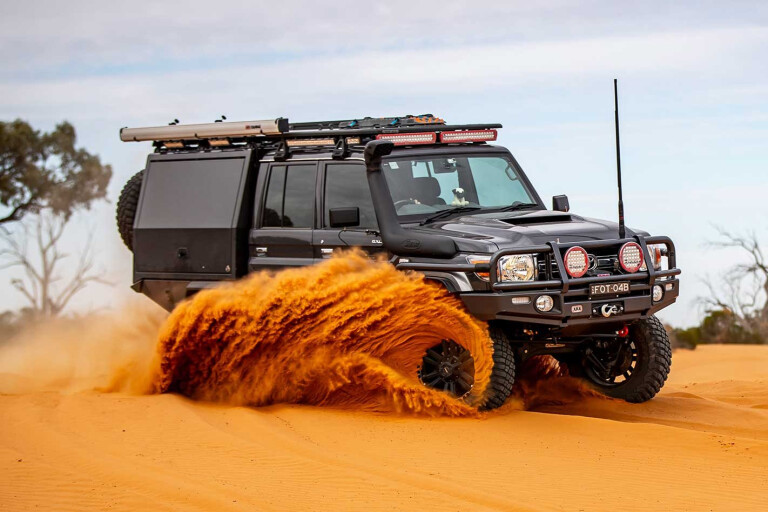
Unless you’ve been hiding under a rock, you’ve probably heard something about Michael Ellem’s ‘Mighty 79’ Landcruiser.
Perhaps you’ve seen pictures of it on Instagram or Facebook, or videos of it on YouTube. You may have even seen it in the metal at a 4x4 show or an ARB open day, or even witnessed it traversing the Simpson Desert, scrabbling around the Flinders Ranges or climbing through the High Country. After all, this vehicle gets around… a lot!
In fact, in the 12 months since it’s been on the road, the Mighty 79 has already covered an astonishing 65,000km, hauling its heavy payload of photographic gear wherever it’s needed to capture spectacular images of other 4x4s doing their thing, as well as the amazing landscapes in which they do it.

Michael is the man behind Offroad Images, the company that captures some of the most striking ‘off-road images’ in Australia, in some of the most spectacular and hard-to-get-to places in this country. And with an ever-increasing list of still and video equipment to lug around, when Michael started searching for a vehicle to replace his not-big-enough-anymore Mazda BT-50, he couldn’t find anything suitable, so he decided to buy a new LC79 Double Cab, strip it completely and rebuild it from the ground up.
“The best thing about a 79 Landcruiser is you can turn it into absolutely anything,” says Michael Ellem, adding, “Our intention with this one was to turn it into the ultimate camera truck.”
Higher and wider
Michael picked up the new Landcruiser at Illawarra Toyota in Wollongong and before it was registered it was shipped down to Marks 4WD Adaptors in Melbourne where a portal axle kit was fitted. Not only does this provide a hell of a lot more ground clearance, it also corrects the Landcruiser’s mismatched front and rear wheel tracks.
“As a part of the portal upgrade, one of the major components we give you is the wide-track diff,” explains Leigh Hardman from Marks 4WD Adaptors. “We manufacture a full diff housing, so it’s the correct width, and then the portal gearbox is bolted to that.
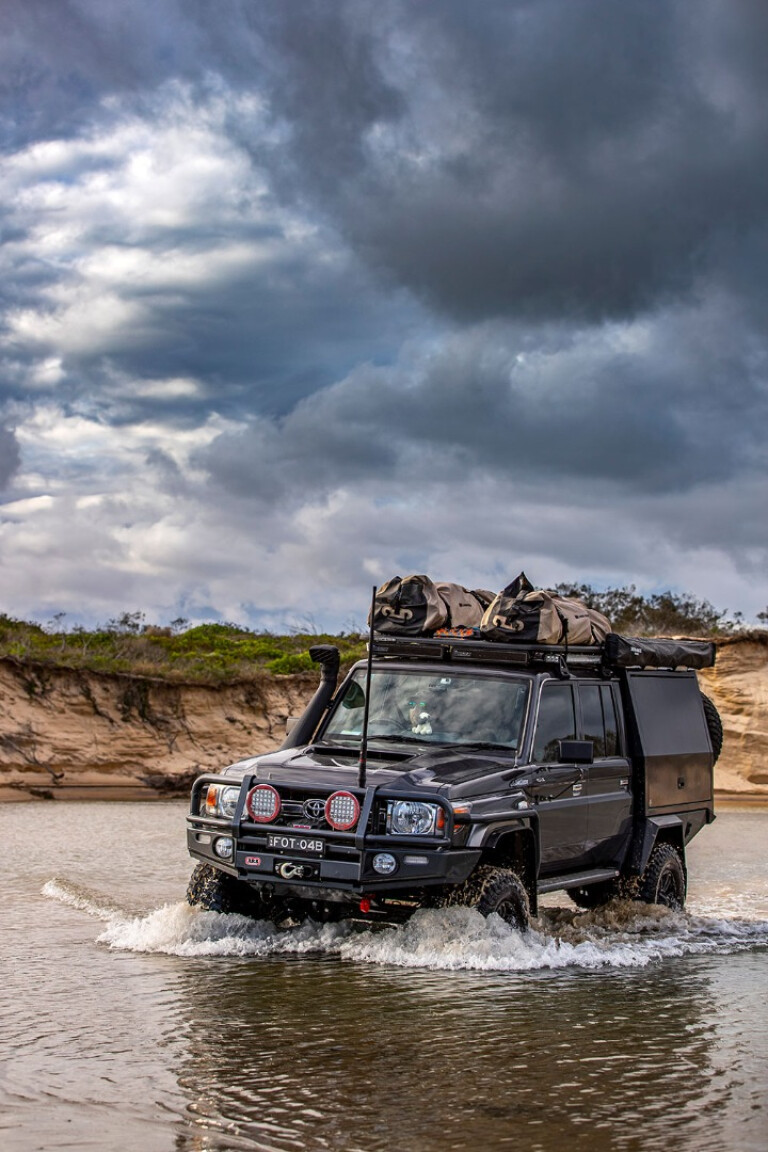
“We also upgrade the swivel housing, so it’s a one-piece swivel housing compared to the factory two-piece swivel housing, and we run a full breather system for the portal axles and the diffs, we run breather lines right up into the engine bay, and we upgrade the brakes.”
The portal axle package has other benefits, too: it allows the legal fitment of 35-inch tyres; it incorporates a GVM upgrade from 3300kg to 3950kg; and includes an upgraded brake system with Delios rotors, brake pads and braided stainless steel brake lines, along with fitment of a new transmission-mounted drum brake replacing the less-than-effective OE park brake.
“Running 35-inch tyres has been a big request from a lot of our customers,” adds Leigh. “With the portals we can do that; we’ve got the gear reduction there, so it will bring you back to a factory ratio.”
Another benefit of the portal axle kit is the fitment of air locking hubs that are operated via a switch inside the cabin.
Weighty issues
As Marks 4WD Adaptors is a second-stage manufacturer, a new compliance plate was fitted to the vehicle stating the increased GVM and fitment of the 35-inch tyres, ensuring it’s legal in all states of Australia. And with all of the extra load capacity likely to be used on a regular basis, Michael knew it would be imperative to get the suspension set-up right.
“I went through and made a spreadsheet of all I’m going to carry,” says Michael. “I calculated how much would be over the rear diff, factoring in an increased percentage for weight hanging out the back like the spare tyres and a decreased percentage for weight in front of the axle… I came up with a figure of 930kg over the rear axle, so I asked ARB to fit 700kg springs plus an extra leaf, which is rated to about 850kg.”
In addition to the upgraded OME leaf springs, the Mighty 79 is fitted with an Airbag Man air suspension helper kit, and pressure in the bags can be adjusted via an ARB LINX touchscreen interface thanks to fitment of an ARB twin air compressor and air tank beneath the service body.
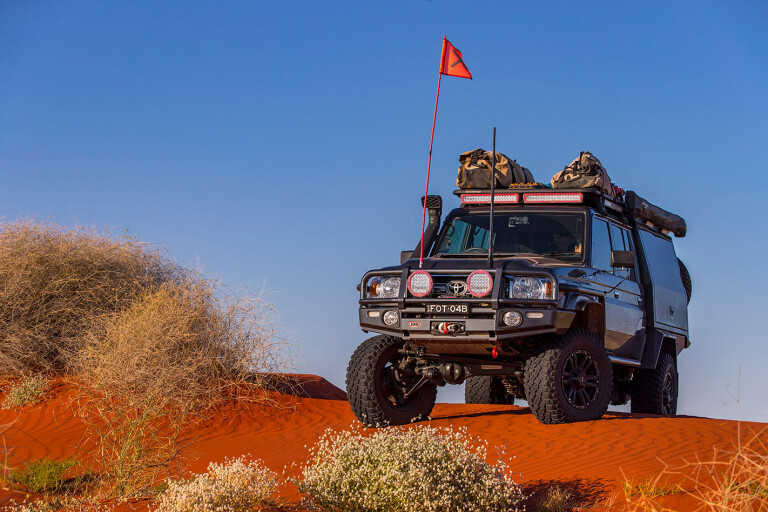
The front-end runs upgraded OME coil springs and there are top-shelf OME BP-51 internal bypass dampers at all four corners, featuring easily adjustable compression and rebound damping to tailor the ride to suit load and driving conditions.
As well as widening the rear track, the portal axle kit adds 200mm to the front track, so the 9 x 18-inch ROH Vapour rims have a +41 offset. Importantly, the wheels also have a heavy load rating, so they’re suited to the GVM upgrade, while an ‘Easycleans’ Matt Black Baked Enamel finish is aimed at providing maximum salt-spray performance and anti-weathering durability.
The Vapours wear BFGoodrich 35x12.50R18LT Mud Terrain T/A KM3 tyres and Michael is impressed with their durability and performance. In fact, he’s so confident in them he’s taken the second spare off the back to save weight (about 45kg), and replaced it with a ladder to access the roof of the service body.
Out the back
That service body was built by Trig Point. It’s manufactured from aluminium and steel, and it has a monocoque construction to provide a balance between light weight and strength. Features include fully sealed doors and filtered air vents to keep out dust and moisture, integration with the vehicle’s central locking system, tapered underbody boxes for maximised departure angle and recessed LED lights. And it looks great!
The Trig Point mounts directly to the 79’s chassis rather than sitting atop a tray like many other bodies on the market, so its roof is in line with that of the vehicle’s cab. “The thing I really like about the Trig Point service body is it’s slung much lower than a normal service body or tray,” says Michael. “This design keeps the weight down which lowers the centre of gravity.”
All Michael has fitted to the canopy top is a Rhino-Rack Batwing awning, an ARB aluminium encased awning, Bushranger LED work lights and two 150W solar panels. “I’ve deliberately fitted solar panels to the roof of the service body so nothing else can be placed up there – no swags, no tripods – so you can’t put any more weight up the top other than whatever dirt is on the shovel,” he says.

The interior of the Trig Point canopy is set up in two halves: the driver’s side for camera work and the passenger’s side for catering. A custom MSA 4x4 drawer system features two large drawers on each side, fitted with LED strip lights.
There’s a flat surface above the drawers for storing Pelican Cases and the like, there’s a full-width cavity at the rear to accept long items such as tripods and light stands, and removable panels at the front for access to four large-capacity lithium batteries that power everything inside the service body.
The batteries are from Revolution Power Australia and are 60A lithium iron phosphate (LiFePO4) units that weigh 24kg in total. These are managed by a Redarc RedVision system. There are two RedVision touchscreen displays inside the service body.
“No matter what side I’m on, I can turn all the features on or off,” explains Michael. “For example, I can turn the fridge on and off, I can turn the USB sockets on and off, I can turn the pie oven on and off, I can see how much water we’ve got left, I can see how long the battery life is going to run and I can get stats of how much charge we’ve been getting… if it’s less today than it was three days ago, I might have to clean the solar panels, so it gives me all that information.”
All of the electrical equipment in the service body – the neat wiring, fuse box, 3000W inverter and master switch – is in plain view and easy to reach, and for peace of mind “the service body has all been wired up by a licenced electrician for the 240V set-up and an automotive electrician for the 12V set-up”, says Michael.
Sure, a 3000W inverter might seem like overkill for the average 4x4 tourer, but Michael uses a lot of power when working, for charging batteries, running computers and, of course, brewing coffee. Easily accessed in the service body are eight 240V AC outlets, four USB outlets and two 12V DC accessory outlets. There’s also Narva interior lighting, including LED lights on the back, ceiling and lift-up doors of the service body, as well as in the drawers.
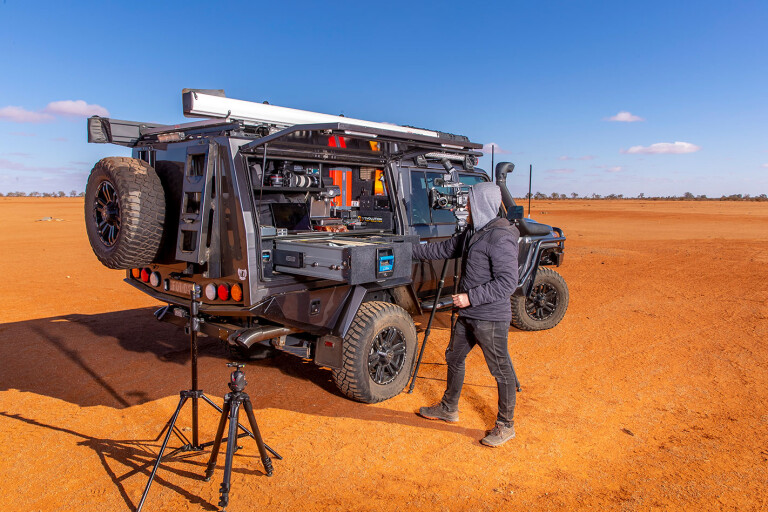
Total coverage
One of Michael’s biggest clients is ARB, so it’s little surprise the Mighty 79 is protected by a colour-coded ARB Large Tube Deluxe bull bar up front. The underside of the Cruiser is covered by an ARB UVP (under vehicle protection) system and there’s an ARB rated recovery point.
Mounted to the bull bar are a pair of AR32 Intensity LED driving lights in a spot/flood combination, while a Warn Zeon 12-S Platinum provides ample winching capacity if required.
ARB Side Rails and Steps provide protection for the side of the vehicle and the lower sills, and make it easier to climb into the cabin, which is much higher up than a standard Cruiser.
As well as the AR32s on the bull bar, additional lighting is provided by a pair of AR40 Intensity LED light bars mounted to a cab-mounted Rhino Rack Pioneer Platform, while side-mounted Bushranger Nighthawk LEDs provide light for camping and working at night.

Inside story
The Mighty 79’s cabin has scored special features, including three Recaro seats – two up front and one in the back next to a custom-made storage system behind the driver’s seat that’s bolted down to the floor of the cab. The seating set-up was fitted by Recaro in Melbourne and signed off by two engineers prior to the vehicle being registered as a three-seater.
“The three-seat conversion is the ideal set-up with all the camera equipment we need to carry in the cabin such as lenses, bodies and batteries,” says Michael. “All up there’s around 80kg of camera equipment in the cab rather than over the rear axle in the service body, so it moves a substantial amount of weight forward.”
Front and rear centre consoles were manufactured by Sydney-based company Department of the Interior and finished in material to match the Recaros. The rear console has a couple of USB ports and a cupholder.
There’s a LINX touchscreen mounted up front, an Outback 4WD Interiors roof console housing a GME TX4500 UHF, a Hema HX-1 mounted where the redundant rear-view mirror used to be and a 4K dashcam at the top of the windscreen.

A nine-inch Power Vision Sound (PVS) head unit with built-in GPS runs Hema mapping, Google Maps and Spotify, and it’s mated to an OBD II Scanner to display vital engine information including exhaust gas temperature, DPF burn temperature, instant and average fuel economy, GPS speedometer, engine temperature and more.
Separate to the power system in the service body, and ensuring there’s enough electrical grunt for all the gear in the cab, is a dual-battery set-up with an Optima Yellow Top battery. “It’s a twin battery system with a 25A BCDC1225D battery charger,” says Michael. “Inside we’ll be charging up iPads, and when iPads are used for mapping, they work the batteries pretty hard.”
Breathing easy
With the retention of standard gearing, Michael didn’t see the need to go overboard with engine modifications, which have been limited to the fitment of a Safari ARMAX snorkel, an ARMAX ECU and a GSL Fabrications exhaust system that runs from the DPF back.
“The most impractical thing I have on this vehicle is the exhaust,” laughs Michael. “I don’t really need it, but it looks good and it sounds great, and at the end of the day it helps the engine breathe better. It’s all stainless steel and it’s completely custom made.
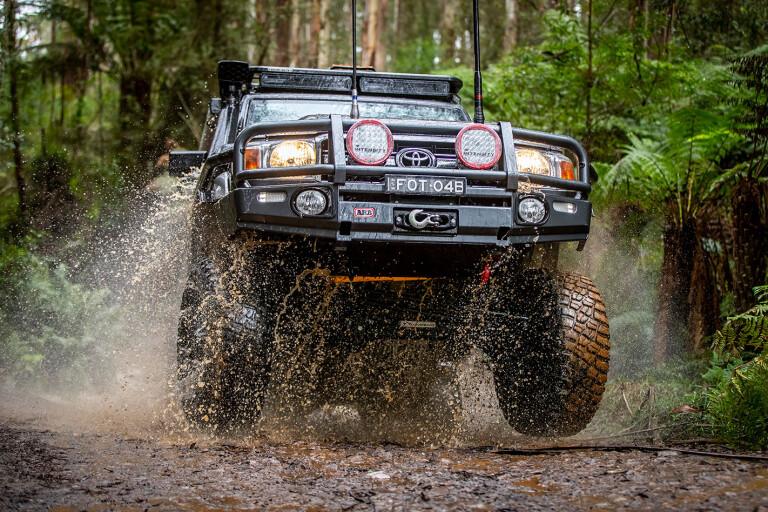
“To make sure the DPF is protected from what’s happening at the front, we’ve gone for a Safari ARMAX ECU, which measures exhaust temperatures prior to the DPF. If it gets too hot the ARMAX will cut power and performance to make sure it protects the DPF.”
Safari 4x4 Engineering also installed a heavy-duty clutch to handle the Mighty 79’s weight, as well as the increased power and torque from its 4.5-litre TDV8.
Working hard
The main objective behind the design of the Mighty 79 was to make working out of it easy, so it’s been set up to provide access to gear and plenty of power to charge batteries and run computers.
“Figuring out where everything goes took a while,” says Michael. “I even adjusted the positioning of the cameras in the camera bag because with everything up quite high it’s easier to pull a long lens out of one side than the other.”
The Mighty 79 also had to be a vehicle that Michael, his wife Gab and at times a third crew member could live out of for weeks at a time in remote areas, and keeping food-prep facilities on the passenger’s side and the camera equipment on the driver’s side proved to be a good move.

“In our previous vehicle, we used to have some complicated times at the start of the day or in the middle of lunch, where I was trying to get to gear to do some shooting but at the same time Gab was trying to prepare food for the crew, but we don’t have that problem at all now,” says Michael.
And with the coffee machine situated on the camera side of the vehicle, Michael can also brew a double-shot ristretto whenever he wants without getting in Gab’s way.
How does it go?
With OME BP-51 dampers all round and Airbag Man air helper bags in the rear, the Mighty 79 offers plenty of scope for suspension adjustment, and it took a couple trips to sort out the best settings for on- and off-road conditions.
On its first trip across the Madigan Line in the northern Simpson Desert, Michael eventually settled on 8psi in the airbags for the load the vehicle was carrying, while he had the rebound damping on the front and rear BP-51s dialled up to ‘9’, with front compression set to ‘3’and rear compression set to ‘5’.

“It drove really well once I got the pressures and settings right,” says Michael. “The first couple of days, every time I pulled up, I’d make adjustments. And then I’d look across to Gab and ask, ‘What do you think? Do you think that’s better?’ and she’d say, ‘Oh, I can’t feel the difference.’ [laughs], but she really did once we got the set-up right.”
Having not previously run 35-inch BFG muddies, Michael also had to learn what tyre pressures would work best. “I know what tyre pressures people should run in a 200 Series or a dual-cab Hilux or Ranger, but this is an entirely different type of vehicle,” explains Michael. “It’s big, it’s got a different stance, it carries a load differently to a typical dual-cab, so it took me a fair bit of time at the start of the trip to work out what pressures I should be running.”
At the end of its Madigan Line shakedown run, Michael says the thing that impressed him the most was how reliable the Mighty 79 proved to be, with no mechanical or equipment failures at all. “It’s testament to the excellent quality of the gear fitted to the Mighty 79, as well as the professionalism of the people who fitted it.” says Michael.
And now, with 65,000km under its belt, Michael is happier than ever with his Mighty 79 camera rig.
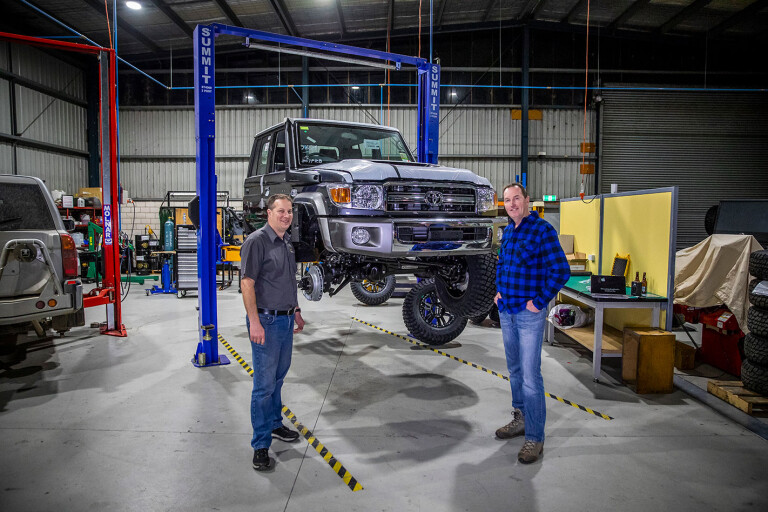

COMMENTS